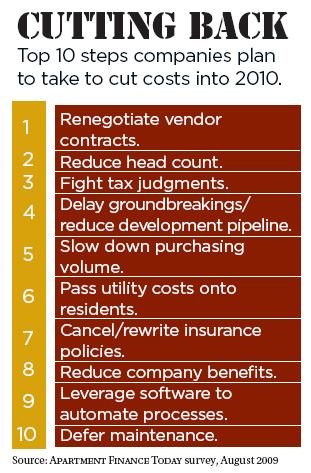Indeed, renegotiation of property taxes and insurance costs factored largely into The Connor Group’s $5.6 million expense cut in 2009, and with continued diligence in that area, coupled with other creative expense reductions, Connor expects—and is asking for—another $1 million to $2 million in savings for 2010.
11. Empower Residents to Slash Energy Costs.
For multifamily property developers and operators historically focused on higher density and more energy-efficient, walkable communities, the green wave of the first decade of the 21st century was testament rather than revelation. Still, the jury is out on whether residents intrinsically look to their apartment communities during consideration of carbon footprints, particularly given the economy. “For most residents in this environment, price is a larger consideration than green,” sums up Simon’s Baron.
REIT UDR has been conducting ongoing research on resident environmental consciousness, and CEO Toomey says more needs to be done to reach out to residents and partner up on the green effort. “We’re constantly questioning what we can do to further reduce energy consumption, but more importantly, how do we educate our residents in that effort?” Toomey says.
UDR might want to consider the success of Campus Advantage, which embarked on a pilot resident education program in 2009. “After installing low-flow fixtures, shower aerators, compact fluorescent light bulbs, and programmable thermostats, we implemented a very simple contest among residents to see who could reduce their consumption the most,” Peter says. “The total cost to us was $9,300 on this property, and our utility savings this year was $40,000. Anybody who thinks green is touchy-feely is flat-out wrong. There are still simple things to be done to achieve tremendous savings.”
MANAGEMENT AND OPERATIONS
12. Be Prepared for the Worst.
Whether you anticipate recovery in multifamily real estate to be V-shaped or subscribe to a hockey stick performance model, experts agree that 2010 is going to look a lot like 2009, and that means continued threats to the bottom line. Simply battening down the hatches and riding out another four quarters might not even be enough: Some pundits recommend running your organization through disaster drills before crisis arrives.
“We are still in survival mode here,” says Patterson of ZOM Residential. “You need to plan for the worst, and the worst in this particular snapshot could be pretty bad. Spend some time walking through these doomsday scenarios, including bankruptcy. I recognize that sounds like a dreary prospect, but as a good company manager and steward, you need to be looking for a below-the-waterline hit, and make sure that if you take one, you can still somehow stay afloat.”
13. Improve the Organizational Chart.
Part of the 2010 business plan at Western National is to continue a position-by-position appraisal of company staff. “From the top to the bottom, we continue to evaluate both the contributions and commitment that people are giving every day,” Shelton says. “We will look to consolidate responsibilities and positions where that makes us a stronger company.” As the economy recovers, many multifamily operators say 2010 will be an apt time to recruit industry talent that fell victim to the recession. “When so many people have been laid off or mistreated by other employers, it is an opportunity to strengthen your organization,” says Bozzuto, who adds that The Bozzuto Group will continue to focus on deepening its marketing unit, particularly with younger, tech-savvy employees. “The focus, quite honestly, has been to hire young people who really understand how to market to young people and really understand social media in a way that most of us could never hope to.”
For multifamily units that kept the team intact, the industry job market picture is a double-edged sword, allowing for responsiveness to market changes but perhaps dictating a pass on available top talent. “We’re pretty solid with our team,” says Simon’s Baron. “We would rather keep people than staff up and staff down.”
14. Train to Retain.
Other firms are hoping to consolidate if job vacancies do arise. RMK didn’t resort to layoffs in 2009, and Pittro doesn’t expect to cut into jobs at the firm for the duration of 2010. Nevertheless, Pittro expects to consolidate roles should any particular job position become vacant. That in itself could offer additional retention benefits on the employee side as well as cost savings to the personnel line item on the budget.
